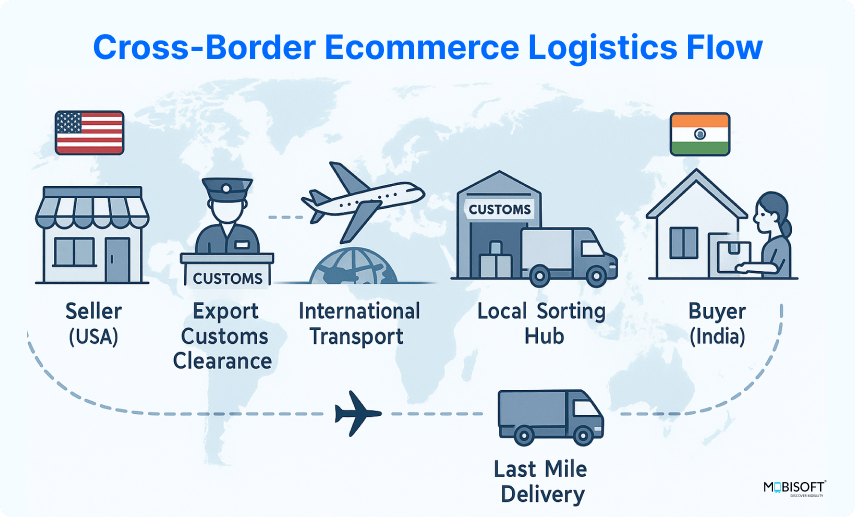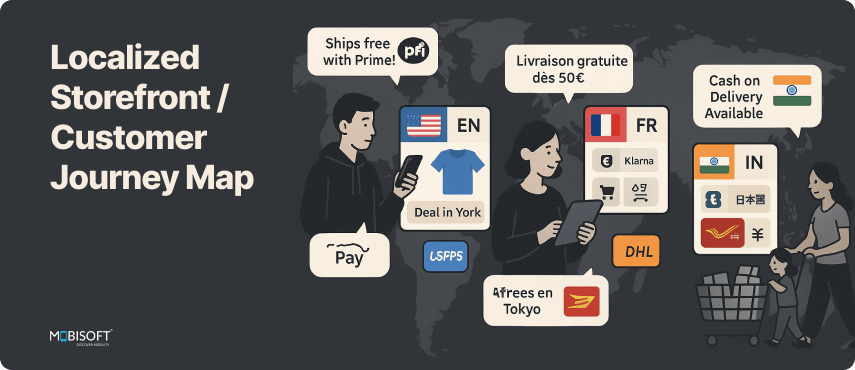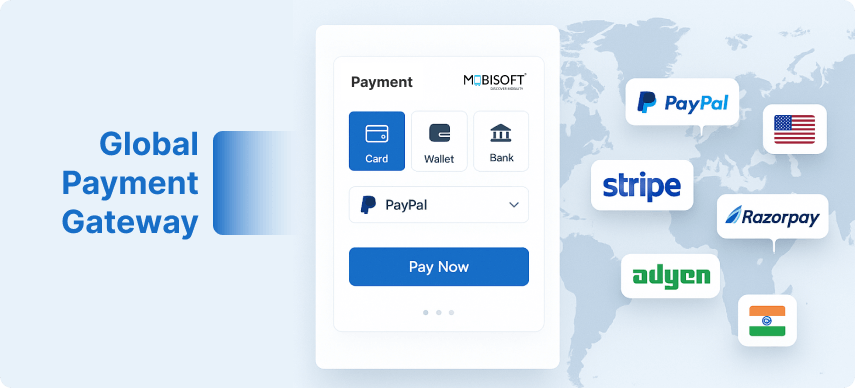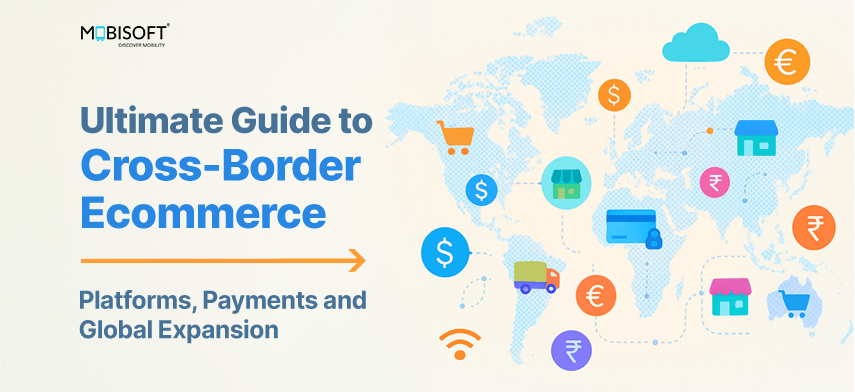The global ecommerce business landscape has undergone a seismic shift. Cross-border ecommerce is no longer a luxury reserved for multinational corporations; it's become an essential survival strategy for businesses of all sizes. With the global cross-border e-commerce market projected to reach $4.81 trillion by 2032, growing at an impressive 18.4% CAGR, we're witnessing the democratization of international trade.
This transformation is particularly significant for entrepreneurs and businesses in emerging markets like India, where digital infrastructure has matured rapidly, consumer behavior has shifted toward global purchasing, and technology has leveled the playing field.
Today, a handloom weaver in Varanasi can sell directly to customers in New York, a spice merchant in Kerala can reach food enthusiasts in London, and a jewelry designer in Jaipur can showcase their creations to buyers worldwide through modern ecommerce platforms.
The barriers that once made international commerce prohibitively complex ecommerce import regulations, payment processing challenges, customs for ecommerce, and international shipping solutions, have been systematically dismantled by innovative technology solutions and improved global infrastructure.
The Cross-Border E-commerce Revolution
The numbers tell a story of unprecedented opportunity. Global ecommerce marketing is set to reach $8.09 trillion by 2028, with cross-border sales representing an increasingly dominant portion of this growth. The cross-border ecommerce market size is expected to surge from $1.47 trillion in 2025 to $4.81 trillion by 2032, making it one of the fastest-growing segments in digital commerce.
What makes these figures particularly compelling is the consumer behavior driving them. Today, 59% of global shoppers purchase from retailers outside their home country, with 35% doing so at least monthly. This represents a fundamental shift in consumer psychology; shoppers are no longer constrained by geographic boundaries when seeking products, experiences, or brands that resonate with them.
This shift is being driven by several converging factors:
Digital Trust and Familiarity
Consumers have become comfortable with online transactions, even across borders. The pandemic accelerated this trust, normalizing digital-first shopping experiences.
Global Brand Discovery
Social media platforms have created a global showcase where consumers discover brands from around the world organically. A food blogger in Mumbai can influence purchasing decisions in Melbourne, creating ripple effects across continents.
Quality and Authenticity Seeking
Modern consumers prioritize unique, authentic products over mass-produced alternatives. They're willing to wait longer and pay more for artisanal goods, sustainable products, or items with compelling stories.
Price Transparency
Digital tools now make it easy to compare prices globally, leading consumers to seek the best value regardless of geographic origin.
For Indian businesses, this represents an unprecedented opportunity. The global appetite for authentic, handcrafted, and culturally rich products aligns perfectly with India's manufacturing strengths and cultural heritage. By choosing the best platforms for cross-border sales, businesses can strategically enter new markets.

Geographic Hotspots Driving Growth
Understanding where the growth is happening helps businesses prioritize their expansion efforts:
Asia-Pacific Dominance
Asia-Pacific commands 29.4% of the global cross-border ecommerce market share in 2025, led by China's massive $1.26 trillion in online sales and India's explosive 23.6% CAGR through 2030. This region's dominance is driven by several factors:
- Massive population bases with growing disposable incomes
- Rapid infrastructure development, particularly in mobile and payment technologies
- Cultural adaptability and entrepreneurial spirit
- Government support for digital initiatives
Southeast Asia's Explosive Growth
Southeast Asia represents perhaps the most exciting opportunity, with the internet economy projected to exceed $330 billion by 2025. Countries like Vietnam, Thailand, and the Philippines are expected to more than double their ecommerce business market values by 2030. For Indian businesses, this region offers:
- Cultural familiarity and shared historical connections
- Similar mobile-first adoption patterns
- Growing middle-class populations with increasing purchasing power
- Relatively less saturated markets compared to Western countries
Here, building a localized approach through localizing the ecommerce storefront and aligning with regional market entry strategy, ecommerce will be vital.
North America's Stability
North America holds 24.3% of the cross-border ecommerce market, driven by sophisticated infrastructure and high purchasing power. This market offers:
- Premium pricing opportunities for quality products
- Well-established logistics and payment infrastructure
- Strong consumer protection laws that build trust
- High digital adoption rates across all age groups
Europe's Maturity
Europe continues as a mature market with strong intra-regional trade and well-developed logistics networks. The European market provides:
- Sophisticated consumers are willing to pay for sustainability and quality
- Strong regulatory frameworks that create trust
- Excellent logistics infrastructure for efficient delivery
- Growing interest in ethical and artisanal products
Complying with cross-border ecommerce compliance, cross-border ecommerce compliance and taxes, and applying multilingual seo for ecommerce will position businesses to scale effectively in the region.
Modern E-commerce Platforms: The Foundation of Global Reach
The ecommerce platform landscape has revolutionized how businesses approach international commerce. Gone are the days when setting up cross-border ecommerce operations required months of development and massive technical resources.
Shopify's Global Dominance: With a 26.2% market share among ecommerce platforms, Shopify has become the platform of choice for cross-border sales. Their success lies in making international commerce accessible through:
- Built-in International Capabilities: Currency conversion, tax compliance, and regional domains are standard features, not expensive add-ons
- Multi-Market Management: Businesses can manage multiple countries from a single dashboard, adjusting pricing, inventory, and content for each market
- Local Payment Integration: Support for region-specific payment methods without complex technical integration
- SEO and Localization Tools: Built-in tools for creating localized content and optimizing for regional search engines
For Indian businesses, Shopify’s integration with local payment systems like UPI, combined with international capabilities, creates a seamless bridge between domestic and global operations. These features make Shopify one of the best platforms for cross-border sales.
Businesses must carefully assess B2B ecommerce features for efficiency when choosing platforms that support scalability, multi-market selling, and operational visibility.
WooCommerce's Flexibility
Following with 20.1% market share, WooCommerce provides flexibility through its WordPress ecosystem and extensive plugin library for international functionality. This ecommerce platform appeals to businesses that need:
- Complete control over their ecommerce business experience
- Custom integrations with local service providers
- Cost-effective solutions for complex requirements
- Extensive customization capabilities
Emerging Platforms
BigCommerce, Magento, and other ecommerce platforms are also evolving to offer international capabilities out of the box, creating a competitive environment that benefits businesses looking to expand globally through scaling ecommerce internationally.
These modern ecommerce platforms offer capabilities that were once available only to large enterprises:
- Real-time Currency Conversion: Automatic conversion with locked exchange rates at checkout, eliminating surprise costs.
- Automated Tax and Duty Calculations: Integration with services like Avalara to calculate and display total costs upfront.
- Multi-language Support: Built-in translation capabilities and localized checkout experiences.
- Integrated International Shipping: Partnerships with global logistics providers for seamless shipping solutions.
- Regional Payment Method Compatibility: Support for local payment preferences without technical complexity
Payment Solutions Revolution: Breaking Down Financial Barriers
Payment infrastructure has transformed from a major barrier to a competitive advantage. Modern international payment gateways have solved the primary friction points that previously prevented cross-border ecommerce.
Stripe's Developer-Friendly Approach
Stripe leads with developer-friendly APIs and support for 100+ global ecommerce payment methods. Their platform enables:
- Global Payment Method Support: From credit cards to local banking systems, digital wallets to buy-now-pay-later solutions
- Intelligent Routing: Automatic routing of payments through the most cost-effective and reliable channels
- Built-in Fraud Protection: Advanced machine learning algorithms to detect and prevent fraudulent transactions
- Real-time Currency Conversion: Transparent exchange rates with no hidden markups
Stripe is widely adopted by modern ecommerce businesses and integrates well with global platforms, making it one of the most reliable cross-border ecommerce payment gateways.
To address this shift, investing in custom ecommerce solutions for cross-border selling helps tailor the experience for different regions, currencies, and tax systems.
Adyen's Enterprise Excellence
Adyen excels in enterprise solutions with support for 94 payment methods and omnichannel capabilities. Their strength lies in:
- Single Platform Integration: Managing online, mobile, and point-of-sale payments through one integration
- Local Acquiring: Processing payments locally to improve acceptance rates and reduce costs
- Advanced Analytics: Deep insights into payment performance across different markets and channels
- Compliance Management: Automatic handling of regional compliance requirements
The Digital Wallet Revolution
The shift toward digital wallets is accelerating dramatically, with 60% of global digital transactions now processed through mobile payment solutions. This trend is particularly important because:
- Consumer Preference: Younger consumers prefer the speed and convenience of digital wallets
- Security Perception: Digital wallets are perceived as more secure than traditional card payments
- Mobile Optimization: Digital wallets are designed for mobile-first experiences
- Regional Variations: Different regions prefer different wallet solutions
Digital wallets are expected to account for 51.4% of cross-border ecommerce transactions in 2025, making their integration essential for international success.
Indian Payment Innovation
India's ecommerce payment ecosystem, led by UPI, has become a model for the world. With UPI accounting for 55% of online transactions in India, Indian ecommerce businesses have a unique advantage in understanding and implementing digital payment solutions. Services like Razorpay and PayU have evolved to offer international payment gateways, allowing Indian businesses to leverage their domestic payment expertise globally.
Logistics and Fulfillment Networks: Solving the Physical Challenge

Modern ecommerce logistics providers have transformed international shipping solutions from a complex nightmare into a manageable, often automated process.
ShipBob's Global Network
ShipBob's global fulfillment network enables brands to store inventory closer to customers across the US, Canada, Europe, and Australia. This approach provides:
- Reduced Shipping Costs: Local fulfillment dramatically reduces shipping distances and costs
- Faster Delivery Times: Customers receive products in days rather than weeks
- Inventory Optimization: AI-driven inventory placement based on demand patterns
- Returns Management: Local returns processing improves customer experience
ShipBob addresses one of the key cross-border ecommerce logistics challenges by simplifying fulfillment across multiple regions.
DHL's Global Reach
DHL continues to lead in cross-border ecommerce with a presence in over 220 countries. Their strength lies in:
- Express Delivery Networks: Reliable next-day and 2-day delivery options globally
- Customs Expertise: Deep knowledge of international trade regulations and customs procedures
- Track and Trace: Comprehensive visibility throughout the shipping process
- Specialized Services: Solutions for specific product categories like fashion, electronics, or perishables
Indian Logistics Evolution
Indian logistics companies like Delhivery, Blue Dart, and newer players like Shiprocket have developed international ecommerce shipping solutions that serve Indian businesses well:
- Cost-Effective Solutions: Competitive pricing for international shipping from India
- Local Understanding: Deep knowledge of Indian business practices and requirements
- Technology Integration: Modern APIs and tracking systems comparable to global standards
- Cash-on-Delivery Expertise: Experience with alternative payment models that can be valuable in emerging markets
The logistics market itself is projected to grow from $1.5 trillion in 2025 to $2.8 trillion by 2033, driven by several technological innovations:
- AI-Powered Optimization: Machine learning algorithms optimize delivery routes, predict demand patterns, and manage inventory placement to reduce costs and improve delivery times.
- Automated Customs Clearance: AI-powered systems expedite border processes by automatically generating required documentation and predicting potential ecommerce import regulation issues.
- Real-Time Tracking and Transparency: Modern systems provide complete visibility from warehouse to doorstep, improving customer confidence and reducing support inquiries.
- Sustainable Shipping Solutions: Carbon-neutral options and electric vehicle adoption address growing consumer demand for environmentally responsible delivery.
Consumer Behavior and Market Dynamics

Mobile-First Commerce: The New Default
Mobile commerce represents the future of scaling ecommerce internationally, and understanding this shift is crucial for success. Mobile transactions will account for 59% of total ecommerce business sales by 2025, reaching $4.01 trillion globally.
This mobile-first trend is particularly pronounced in emerging markets, where mobile adoption leapfrogs desktop entirely. In Southeast Asia, 88% of cross-border ecommerce transactions occur on mobile devices, creating a market well suited for Indian businesses that have already mastered mobile-first experiences.
Key Mobile Commerce Trends:
App Preference Over Mobile Web
73% of consumers prefer shopping apps over mobile websites, driving the need for native mobile applications rather than just responsive websites.
Improved Mobile Conversion
Mobile conversion rates have increased 30% in the past two years as user experience design has improved and consumers have become more comfortable with mobile transactions.
Push Notification Effectiveness
Push notifications increase conversions by 88% when used effectively, providing a direct communication channel with customers.
Mobile Spending Power
The average mobile shopper spends $2,500 annually, demonstrating significant purchasing power through mobile channels.
Indian Mobile Advantage
Indian businesses have a significant advantage in mobile commerce because India's e-commerce ecosystem was developed mobile-first in the beginning. This experience in designing for mobile-first consumers translates directly to success in other emerging markets with similar adoption patterns.
Mobile Payment Integration
The integration of mobile wallets, UPI-style payment systems, with buy-now-pay-later options directly into mobile shopping experiences creates frictionless purchasing processes that drive higher conversion rates.
Indian businesses already leading in mobile-first strategies can expand globally with mobile ecommerce app development for a global audience, designed to meet localized demands across devices.
AI-Powered Personalization: Creating Individual Experiences at Scale
Artificial intelligence is transforming the shopping experience from a one-size-fits-all approach to individualized experiences that adapt to each customer's preferences, behavior, and context.
The e-commerce AI market, valued at $7.25 billion in 2024, is projected to reach $64.03 billion by 2034, indicating massive investment and rapid adoption across the industry.
AI Applications in Cross-Border Commerce:
Hyper-Personalized Product Recommendations
AI analyzes browsing behavior, purchase history, and similar customer patterns to recommend products that individual customers are most likely to purchase, significantly increasing conversion rates and average order values.
Predictive Analytics for Inventory Management
AI forecasts demand patterns across different markets, enabling businesses to position inventory optimally and avoid stockouts or overstock situations.
Dynamic Pricing Optimization
AI adjusts to pricing in real-time based on demand, competition, currency fluctuations, and customer willingness to pay, maximizing revenue while remaining competitive.
24/7 Multilingual Customer Support
AI chatbots provide customer service in multiple languages across different time zones, reducing support costs while improving customer satisfaction.
Visual Search Capabilities
AI enables customers to search for products using images rather than text, particularly valuable for fashion, home decor, and lifestyle products where visual appeal is paramount.
Cultural Adaptation
AI analyzes regional preferences and adapts product presentations, color schemes, and marketing messages to local cultural preferences automatically.
Indian AI Innovation
Indian companies like Haptik (acquired by Reliance) and numerous startups are developing AI solutions specifically for e-commerce applications. This local innovation ecosystem provides Indian businesses with access to cutting-edge AI tools at competitive prices.
Performance Impact
67% of retailers expect AI-powered personalization to drive a 30% revenue increase by 2030, making AI adoption a competitive necessity rather than a luxury.
For businesses targeting multilingual markets and local preferences, leveraging AI Omnichannel Personalization in Ecommerce can significantly boost engagement and conversions.
Social Commerce Integration: Where Discovery Meets Purchase
Social commerce is exploding globally, with the market projected to reach over $1.085 trillion by 2028. This represents a fundamental shift in how consumers discover and purchase products, blending ecommerce marketing directly into the platforms where users already engage.
TikTok Shop's Explosive Growth
TikTok Shop is leading this revolution, with global ecommerce platform sales expected to reach $20 billion in 2023, up from $4.4 billion in 2022. This 355% growth rate demonstrates the power of integrated social commerce for any ecommerce business expanding globally.
Platform-Specific Opportunities:
With 67.8 million buyers expected in 2025, Facebook offers mature ecommerce platform tools, including Facebook Shops, Instagram Shopping, and WhatsApp Business integration.
45.3 million buyers projected for 2025, with particularly strong performance in fashion, beauty, and lifestyle categories. Instagram's visual-first format aligns perfectly with India's strength in visually appealing products.
TikTok
35.8 million buyers are anticipated in 2025, with exceptional performance in viral product discovery and younger demographic engagement.
Social Commerce Advantages for Indian Businesses
Visual Storytelling
Indian businesses excel at visual storytelling, particularly around craftsmanship, heritage, and cultural significance elements that perform exceptionally well in ecommerce marketing on social platforms.
Influencer Culture
India's robust influencer ecosystem provides experience in influencer marketing that translates well to international social commerce.
Community Building
Indian businesses understand community-driven commerce through platforms like WhatsApp Business, providing a foundation for social commerce success.
Authentic Content Creation
The ability to create authentic, culturally rich content gives Indian ecommerce businesses a competitive advantage in global social commerce.
Emerging Markets and Growth Opportunities
Southeast Asia: The Digital Commerce Boom
Southeast Asia represents the fastest-growing ecommerce market, with consumer spending projected to increase 122% over the next decade, well ahead of Latin America (57%) and Africa (103%).
Key Growth Drivers:
- Mobile-First Adoption: 88% of transactions occur on mobile devices, favoring ecommerce businesses with mobile-first experiences.
- Young Demographics: Tech-savvy populations with high smartphone adoption rates and comfort with digital transactions drive rapid market growth.
- Infrastructure Improvement: Extensive fiber cable networks and 5G rollout provide the technical foundation for sophisticated e-commerce experiences.
- Local Payment Innovation: Region-specific solutions like GoPay, OVO, and GrabPay demonstrate the market's embrace of digital payment solutions.
- Cultural Connectivity: Historical and cultural connections between India and Southeast Asia create a natural affinity for Indian products and brands.
Specific Country Opportunities
- Vietnam: E-commerce market expected to reach $39 billion by 2025, with strong growth in fashion, electronics, and home goods.
- Thailand: Sophisticated logistics infrastructure and high internet penetration create opportunities for premium product positioning.
- Philippines: Young population with strong English language skills and a growing middle class provides accessible market entry opportunities.
- Indonesia: Massive population base with rapidly improving infrastructure and strong mobile adoption.
Latin America and Africa: Untapped Potential
These regions are undergoing digital transformation, opening the door for ecommerce businesses willing to localize and adapt.
Latin America Advantages
High Mobile Penetration
Smartphone adoption rates approaching developed market levels create mobile-first shopping opportunities.
Fintech Innovation
Solutions like Pix in Brazil demonstrate rapid adoption of innovative payment solutions, creating opportunities for businesses comfortable with alternative payment methods.
Growing Middle Class
Increasing disposable income, combined with the desire for unique, quality products, creates market opportunities for Indian businesses.
Infrastructure Development
Improving logistics infrastructure reduces delivery times and costs, making cross-border commerce more viable.
Africa's Unique Opportunities
Mobile Money Leadership
Solutions like M-Pesa demonstrate sophisticated mobile payment adoption that surpasses many developed markets.
Young Demographics
Young, growing populations embracing e-commerce create long-term market opportunities.
Infrastructure Investment
Major investments in internet connectivity through undersea cable projects rapidly improve market accessibility.
Alternative Payment Models
Cash-on-delivery and mobile money solutions address banking limitations while enabling commerce.
India: The Growth Engine
India’s ecommerce business growth at 23.6% CAGR is fueled by advantages that also prepare companies for scaling ecommerce internationally.
Digital Infrastructure
850 million internet connections as of 2022 provide a massive domestic market for testing and refining international expansion strategies.
- Payment Innovation: UPI payment system, accounting for 55% of online transactions, demonstrates India's leadership in digital payment adoption.
- Government Support: The Digital India initiative provides policy support for digital commerce development and international expansion.
- Rural Market Expansion: Expanding rural internet access creates domestic growth opportunities while developing capabilities for serving underserved international markets.
Indian Advantages for Global Expansion
Cultural Adaptability
Experience managing diverse domestic markets translates to success in cross-border ecommerce and international expansion.
Technology Leadership
Indian software and technology expertise provides competitive advantages in ecommerce platform development and optimization.
Cost Efficiency
Competitive cost structures enable attractive pricing in international markets while maintaining healthy margins.
English Language Skills
Strong English language capabilities facilitate expansion into English-speaking markets and international business communications, supporting ecommerce marketing globally.
Sustainable Commerce and Environmental Responsibility
Green Shipping Revolution: Meeting Consumer Expectations
Sustainability has transformed from a nice-to-have feature to a non-negotiable requirement. 80% of consumers prefer sustainable delivery options, and 66% are willing to pay more for eco-friendly international shipping solutions.
Industry Response to Sustainability Demands
- Electric Vehicle Adoption: 25-30% of last-mile delivery fleets in India are expected to be electric vehicles, positioning Indian businesses ahead of global sustainability trends.
- Carbon-Neutral Shipping: Major carriers like Maersk, committing to net-zero emissions by 2040, create opportunities for businesses to offer carbon-neutral delivery options.
- Circular Packaging: EU requirements for 70% recyclable packaging by weight drive innovation in sustainable packaging solutions.
- Route Optimization: AI-powered systems are reducing fuel consumption and emissions while improving delivery efficiency.
Sustainable Practices Benefits
- Brand Loyalty: Companies implementing sustainable practices report improved brand loyalty and customer retention.
- Cost Reduction: Long-term operational cost reductions through improved efficiency and reduced waste.
- Market Access: Sustainability credentials are required for access to premium markets and customers.
- Regulatory Compliance: Proactive sustainability measures prepare businesses for increasing environmental regulations.
Indian Sustainability Advantages
- Traditional Practices: Many traditional Indian business practices are inherently sustainable, providing authentic sustainability stories.
- Cost-Effective Solutions: Indian innovation in low-cost, sustainable solutions provides competitive advantages in sustainability implementation.
- Government Support: Indian government initiatives supporting sustainable business practices create policy alignment for sustainable commerce.
Overcoming Traditional Barriers
Modern technology solutions have transformed cross-border ecommerce compliance from a major barrier to a manageable operational requirement.
Automated Compliance Solutions
- Duty and Tax Calculation: Platforms like Avalara and Zonos automatically calculate duties for ecommerce, taxes, and fees, displaying total costs to customers before checkout.
- Documentation Generation: Automated generation of required customs forms, commercial invoices, and other trade documents.
- Regulatory Updates: Automatic updates when trade regulations change, ensuring continued compliance without manual monitoring.
- Multi-Country Management: Single platforms manage compliance requirements across multiple countries simultaneously.
- Real-Time Transparency: Transparent pricing in local currencies, including all fees and taxes, builds customer trust and reduces cart abandonment.
Indian Regulatory Advantages
- Complex Domestic Market: Experience navigating India's complex regulatory environment provides skills applicable to international expansion.
- GST Experience: Understanding of goods and services tax systems translates well to international tax compliance.
- Export Infrastructure: Existing export infrastructure and knowledge provide a foundation for expanded international operations.
Payment Security and Trust: Building Confidence Across Borders

Advanced security measures have addressed the primary concerns that prevented consumers from making international ecommerce purchases.
Security Implementation
- PCI Compliance: PCI-compliant gateways with built-in fraud protection provide enterprise-level security for businesses of all sizes.
- Real-Time Currency Conversion: Locked exchange rates at checkout eliminate surprise costs and currency fluctuation risks.
- Local Payment Method Integration: Support for international payment gateways and regional preferences builds trust through familiar payment options.
- Blockchain Technology: Enhanced transparency and security through distributed ledger technology for high-value transactions.
Trust Building Strategies
- Transparent Pricing: Clear communication of all costs, including shipping, duties, and taxes before checkout.
- Secure Badge Display: A prominent display of security certifications and guarantees builds consumer confidence.
- Customer Reviews: International customer reviews and testimonials demonstrate successful cross-border ecommerce transactions.
- Return Policies: Clear, fair return policies reduce purchase risk and increase conversion rates.
Logistics Innovation: Making Distance Irrelevant
Modern ecommerce logistics and fulfillment strategies have transformed international ecommerce shipping solutions from a complex challenge to a competitive advantage.
Advanced Fulfillment Strategies:
- Distributed Inventory: Multi-warehouse models reduce shipping zones and delivery times while optimizing costs.
- AI-Powered Routing: Optimization of delivery paths, reducing costs while improving delivery speed and reliability.
- Hybrid Logistics: Combining global carriers with local last-mile delivery for optimal cost and service balance.
- Real-Time Tracking: Complete visibility from warehouse to doorstep, improving customer confidence and reducing support inquiries.
- Returns Management: Streamlined international returns processing reduces friction and boosts customer satisfaction, crucial for cross-border ecommerce success.
Indian Logistics Innovation
- Cost Optimization: Indian logistics companies' experience with cost-effective solutions provides competitive advantages in international shipping.
- Technology Integration: Modern Indian logistics platforms offer API integration and tracking capabilities aligned with global ecommerce platform standards..
- Alternative Delivery Models: Experience with cash-on-delivery and flexible delivery options applicable to emerging international markets.
Strategic Implementation for 2025
Building Market Entry Strategy: Foundation for Success
Successful cross-border ecommerce expansion requires systematic execution across key dimensions.
Comprehensive Market Research and Selection:
- Growth Potential Analysis: Using data from emerging markets to identify countries and regions with optimal growth trajectories and market conditions.
- Competitive Landscape Assessment: Understanding local and international competition, pricing strategies, and market positioning opportunities.
- Regulatory Environment Evaluation: Comprehensive assessment of compliance requirements, business registration needs, and ongoing regulatory obligations.
- Consumer Behavior Analysis: Deep understanding of local shopping preferences, payment methods, seasonal patterns, and cultural considerations.
- Infrastructure Assessment: Evaluation of logistics capabilities, internet penetration, payment infrastructure, and market accessibility.
- Partner Identification: Identification of suitable local partners, service providers, distributors, and strategic allies.
Technology Stack Optimization: Building for Global Scale
- Platform Selection: Choosing e-commerce platforms that support international operations from day one, avoiding costly migrations later.
- Payment Gateway Implementation: Implementing payment systems with comprehensive regional method support and fraud protection.
- Inventory Management Systems: Deploying inventory management across multiple fulfillment centers with real-time synchronization.
- Customer Service Infrastructure: Establishing customer service capabilities in local languages across relevant time zones.
- Analytics and Reporting: Implementing comprehensive analytics to track performance across multiple markets and currencies.
- Security Implementation: Ensuring enterprise-level security and compliance across all international operations.
Implementing advanced backend systems like ERP is critical. Our Ecommerce ERP Integration Guide offers a complete roadmap to integrate inventory, finance, and fulfillment data seamlessly.
Localization Beyond Translation: Cultural Adaptation
- Product Adaptation: Modifying product offerings to match local tastes, preferences, sizing standards, and regulatory requirements.
- Pricing Strategy Development: Implementing region-specific pricing strategies that account for local purchasing power, competition, and market conditions.
- Marketing Campaign Localization: Developing culturally relevant marketing campaigns that resonate with local audiences while maintaining brand consistency.
- Legal Compliance: Ensuring compliance with local consumer protection laws, advertising regulations, and business practices.
- Cultural Sensitivity: Training teams on cultural nuances, communication styles, and business practices in target markets.
Operational Excellence Framework: Executing for Success
Supply Chain Management: Global Optimization
- Strategic Inventory Placement: Establishing inventory placement strategies that minimize shipping costs while ensuring product availability.
- Demand Forecasting: Implementing AI-driven demand forecasting using historical data, market trends, and seasonal patterns.
- Supplier Diversification: Creating contingency plans for supply chain disruptions through supplier diversification and alternative sourcing strategies.
- Quality Control: Implementing quality control measures that maintain standards across different fulfillment centers and shipping routes.
- Partnership Management: Building and maintaining relationships with reliable logistics partners, payment processors, and compliance platform providers.
Customer Experience Design: Creating Global Consistency
- Transparent Pricing: Providing clear, upfront pricing including all duties, taxes, and shipping costs to eliminate surprise charges.
- Payment Method Optimization: Offering comprehensive local payment methods and currencies to reduce friction and increase conversion rates.
- Multi-Language Support: Implementing responsive customer service across multiple languages and time zones.
- Returns and Refunds: Creating seamless returns and refund processes that work efficiently across international borders.
- Communication Strategy: Developing proactive communication strategies that keep customers informed throughout the purchase and delivery process.
Performance Monitoring: Data-Driven Optimization
- Key Metrics Tracking: Monitoring conversion rates, cart abandonment rates, customer lifetime value, and other critical performance indicators across different markets.
- Regulatory Monitoring: Staying current with regulatory changes and compliance requirements in all operational markets.
- Customer Feedback Analysis: Systematically collecting and analyzing customer feedback to identify improvement opportunities.
- Market Trend Analysis: Monitoring market trends, competitive developments, and emerging opportunities in target markets.
- Continuous Optimization: Implementing continuous improvement processes based on data insights and market feedback.
Future Outlook: The Borderless Economy
Technological Convergence: The Next Phase
The convergence of AI, mobile commerce, ecommerce platforms, social media, and sustainable practices is creating unprecedented opportunities for businesses willing to embrace integrated approaches.
Mobile-AI Integration
By 2025, 75% of all ecommerce business sales will occur on mobile devices, while AI-powered personalization will drive 30% revenue increases for adopting retailers. This convergence creates opportunities for:
- Personalized mobile experiences that adapt to individual user preferences in real-time
- Voice commerce integration enables hands-free shopping experiences
- Augmented reality product visualization improves mobile shopping confidence
- AI-powered mobile customer service providing instant, contextual support
Social-Commerce Fusion
The integration of social media discovery with commerce functionality creates new ecommerce marketing opportunities for customer acquisition and engagement:
- Influencer partnership programs that drive authentic product discovery
- User-generated content integration that builds trust and community
- Live commerce experiences that combine entertainment with shopping
- Social proof integration that leverages community recommendations
Sustainability-Technology Alignment
The combination of environmental responsibility with technological innovation creates competitive advantages in cross-border ecommerce and beyond:
- Carbon footprint tracking and offset programs integrated into the shopping experience
- Sustainable packaging solutions that enhance brand perception
- Circular economy integration enables product lifecycle management
- Green logistics optimization reduces environmental impact while improving efficiency
Thriving in the borderless economy demands reliable end-to-end ecommerce development services that ensure scalability and compliance from the ground up.
Market Evolution: From Advantage to Necessity
Cross-border ecommerce is evolving from a competitive advantage to a strategic imperative, as consumers increasingly expect global access with a localized experience.
Consumer Expectations
Modern consumers expect the following:
- Seamless International Shipping: Fast, reliable, and cost-effective international ecommerce shipping solutions, regardless of product origin
- Local Payment Methods: Support for international payment gateways, regional banking systems, and alternative payment methods
- Sustainable Alternatives: Environmentally responsible shipping and packaging options with transparent carbon impact information.
- Personalized Experiences: Individualized shopping experiences that adapt to personal preferences, purchase history, and cultural context.
- Social Commerce Integration: Discovery and purchase options are integrated into social media platforms and influenced by community recommendations.
Business Implications
Companies not adapting to scaling ecommerce internationally risk falling behind as:
- Local markets become increasingly competitive with global players
- Consumer expectations rise based on international best practices
- Technology costs for international expansion continue to decrease
- Regulatory barriers continue to be reduced through international trade agreements
Strategic Imperative: Global-First Thinking
The businesses thriving in 2025 and beyond will be those that embrace cross-border commerce as a core strategy rather than an afterthought.
Infrastructure Investment
Successful businesses are investing in international-ready technology infrastructure that supports global operations from inception rather than retrofitting domestic solutions.
Global Scale Operations
Building operations designed for global scale from the beginning, including multi-currency pricing, international logistics, and cross-cultural customer service.
Cultural Competency Development
Developing a deep understanding of local markets, cultural nuances, and consumer preferences in target markets.
Sustainable Business Practices
Creating sustainable business practices that resonate globally while meeting increasing environmental regulations and consumer expectations.
Data and AI Leverage
Leveraging data analytics and AI for competitive advantage in personalization, optimization, and market expansion decisions.
Conclusion: Your Gateway to Global Success
The cross-border ecommerce landscape has undergone a fundamental transformation. What once required significant resources, expertise, and risk tolerance is now accessible to businesses of all sizes through advanced ecommerce platforms, payment systems, and logistics networks.
The ecommerce market opportunity is massive and growing. Consumer behavior has shifted permanently toward global purchasing. The technology infrastructure is mature and readily available. The regulatory environment continues to improve through international cooperation and digital-first government initiatives.
For Indian businesses, this transformation represents an unprecedented opportunity to showcase the country's rich heritage, innovative solutions, and competitive advantages to a global audience. Whether you're crafting traditional textiles in Gujarat, developing software solutions in Bangalore, or creating artisanal food products in Punjab, the global ecommerce marketplace is more accessible than ever before.
Success in this environment requires more than just good products; it demands strategic thinking, technological sophistication, and operational excellence. The businesses that master cross-border ecommerce today are positioning themselves to dominate tomorrow's global ecommerce business landscape.
The infrastructure exists. The demand is proven. The tools are available. The regulatory environment is supportive. The only remaining variable is execution, how quickly and effectively you can adapt your ecommerce platform for global success.
The world has become a single ecommerce market where your customers are everywhere, your competition is global, and your opportunities are limitless. The future belongs to businesses that think globally from day one and execute with local precision in every market they enter.
Your global journey doesn't require moving to Silicon Valley, hiring international teams, or raising millions in funding. It requires understanding the tools available today, learning from the businesses that have succeeded before you, and taking the first step toward serving customers beyond your current borders.
The global ecommerce platform is open for business. The question isn't whether you should participate, it's how quickly you can get started and how effectively you can scale. Your customers are waiting, your products are ready, and the infrastructure to connect them is available today.
The future of e-commerce is borderless. The future of your ecommerce business can be too.





 August 5, 2025
August 5, 2025


